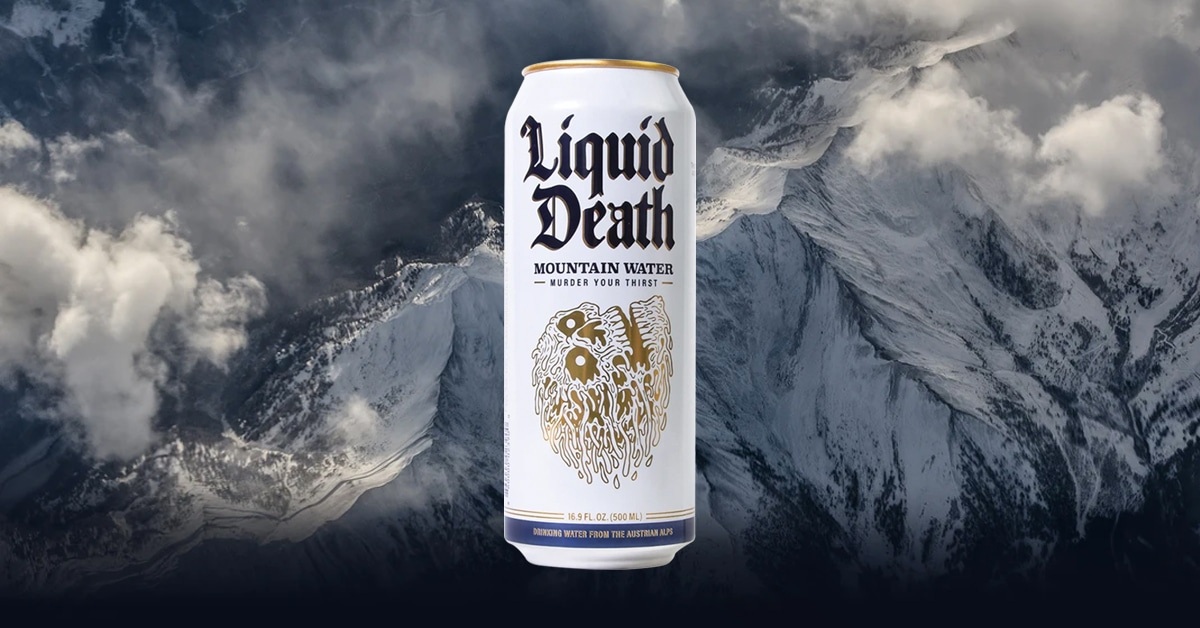

Oct 18, 2022
Canned water company Liquid Death was recently valued at $700 million, making it the fastest growing non-alcoholic beverage brand in history. The edgy, heavy metal-inspired brand was invented when CEO Mike Cessario was at a concert and noticed bands drinking water out of energy drinks bottles. The reason being that the tours were sponsored by the drinks manufacturers, but the bands preferred to drink water on stage.
He set out to provide a cooler alternative for those of us that don’t drink on a night out, but still want to fit in or simply have their own fun drink. With that, he also wanted to take on the plastic industry - Liquid Death comes in cans, which is much easier to recycle, and has an environmental message at its core.

Mike Cessario, CEO of Liquid Death
The bottled water industry is all about branding. Most water sold is just repurposed tap water, with very little opportunity for differentiation. Liquid Death has turned this market on its head and is reaping the rewards. So how exactly has the company done this?

Liquid Death has succeeded in creating its own niche in the market. It specifically targets people who don’t drink alcohol, but still want to fit in. Even more niche, it’s targeting specifically the skateboarding, rock-listening, environmentally conscious amongst these. Many brands and organisations are afraid of targeting such a specific demographic and potentially alienating large swathes of the population, but Liquid Death’s success has shown that their authenticity and commitment to their branding attracts plenty of people beyond its core market.

The other main pillar of Liquid Death is its environmentally conscious approach. In part, they’re a response to big corporations that continue to waste plastic (and fail to recycle the plastic they produce). The product comes in a can, which is much easier to recycle, and its website is covered with educational resources about the harm of the plastic industry. They also donate a portion of the profits from every can sold to numerous clean water and recycling charities.
In a world where people are increasingly conscious about social impact, and more willing to invest in brands that are making a change, Liquid Death is cashing in by making a real difference.

All of Liquid Death’s advertising and communication is experimental and unexpected. Their first ever advertisement is a comedic skit of someone getting waterboarded with Liquid Death (yes, it went viral). Its motto, “Murder your thirst”, turns the typical vitality and health-related branding of bottled water on its head entirely. It’s funny, irreverent, and clearly speaks to younger generations. In 2022 they partnered with the adult film industry to speak to a niche of their niche, creating a campaign series that focused on their environmental credentials (with a comedic twist). (Watch the safe for work video here).

Another thing that sets Liquid Death apart is its merchandise. Not many non-alcoholic beverage brands can claim to have merchandise drops as successful as they do. Last year, the brand made $3M off merchandise alone.
Just like its communications, Liquid Death’s merchandise is disruptive and outside-the-box. In 2021 they sold 100 skateboards with the blood of industry legend (and brand investor) Tony Hawk mixed into the paint. Priced at $500, they sold out in less than twenty minutes. They’ve released vinyls called ‘Greatest Hates,’ where they partner with rock musicians to write songs based on the hate they get online.
None of this merchandise is related to bottled water, or even its environmental message, but appeals to their niche market’s other interests. Not all income has to come from your central brand, product or fundraising streams - the benefit of targeting a niche community is that you can easily play into their other interests, which tend to be fairly uniform.

Clearly, Liquid Death knows its niche demographic through and through. If their communication, merchandise, and aesthetic weren’t enough, they double down on their engagement by choosing the right partnerships for their audience.
Tony Hawk and their death metal collaborators are the obvious ones. But they recently announced a partnership with Martha Stewart, less obvious, who's become a meme in certain demographics for her time spent in prison and her friendship with Snoop Dogg. Similarly clever, they partnered with fictional character The Deep, from edgy TV-hit The Boys.
Choosing these partnerships wisely, and going for niche instead of big name celebrities with broad marketing power, shows an understanding of micro-trends that continues to build loyalty amongst their fans.

Like many brands, Liquid Death has a membership programme. Unlike many brands, their Murder Head Death Club is NFT-based. Since the rise of NFTs, they've been selling 6666 tokens, in the form of severed heads, which get their owners numerous perks.
Perks include access to a private Discord community, events, merchandise drops, and for owners of multiple NFTs - their face could even be tattooed on Liquid Death's CEO.
Liquid Death succeeds in identifying another aligned niche (crypto-nerds), and taps into that whilst maintaining the irreverent communication style that has been working so well for them.
Thinking that NFTs aren't very environmentally friendly? Liquid Death is partnering with Pachama to offset the highest calculated carbon emissions by 110%. Even when they're marketing across niches, they're holding their core values in the highest regard.
Liquid Death has shown the value of unique thinking, and entirely disrupting the market in doing so. Even so, not every organisation wants to or can be a disruptor. For those organisations, Liquid Death shows the power of creating a niche community of fans based around a meaningful product.
If you’d like to know more about marketing to a niche, we’re covering exactly that in our weekly trend article here.